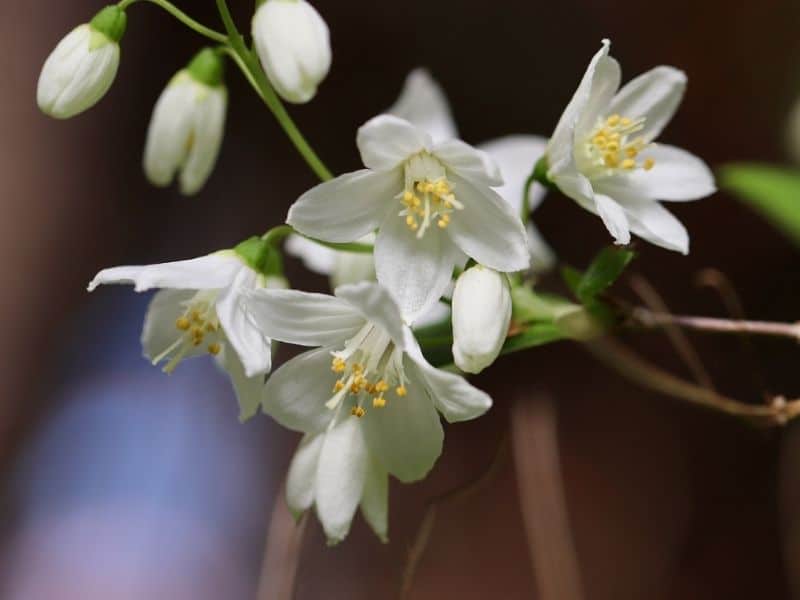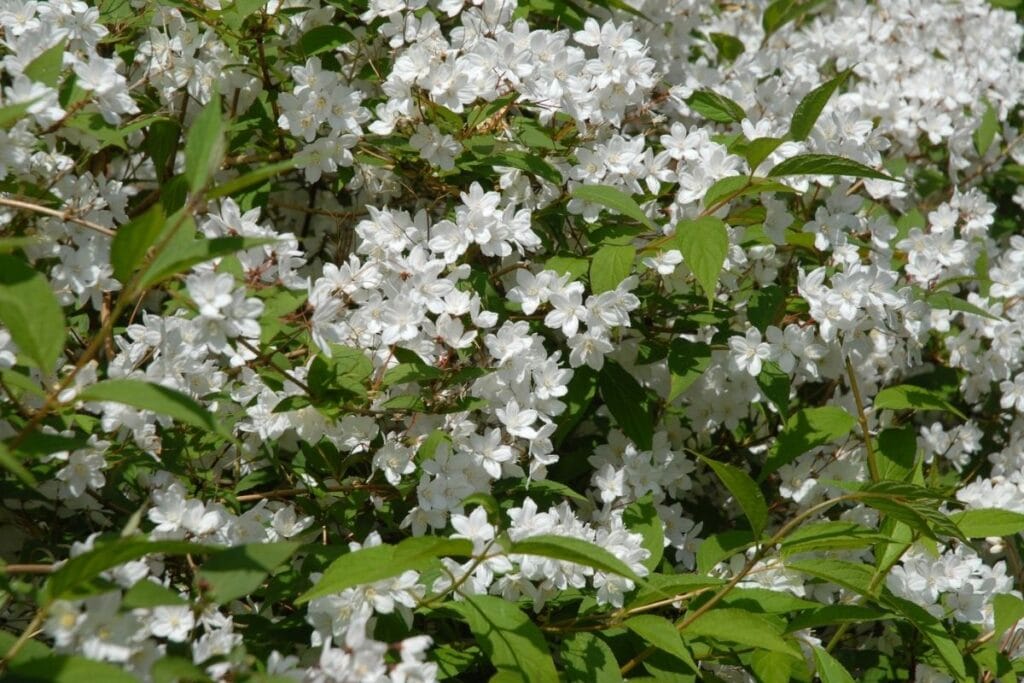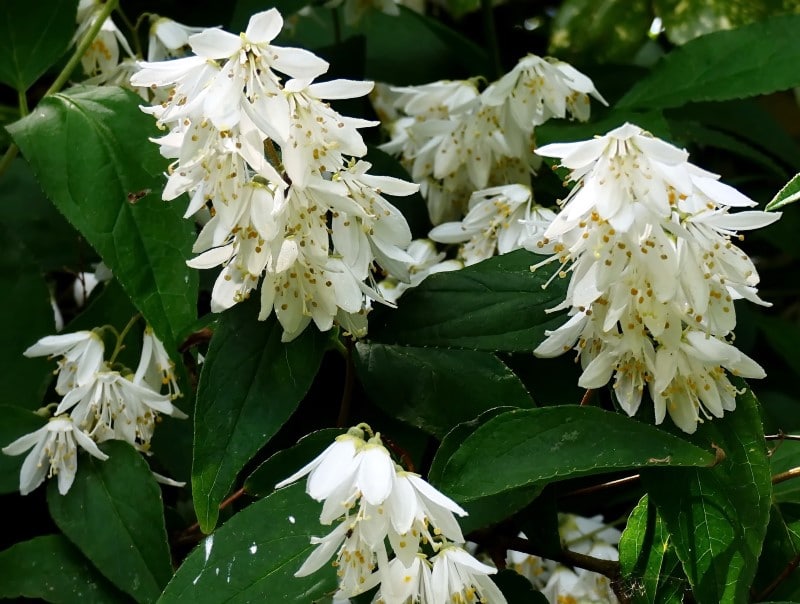Deutzias have long been a popular choice for a woodland garden in zones 5 to 8 that need a little brightness in the spring or summer months.
If you’re looking for a new low-maintenance deciduous shrub, this might be just what you’re looking for. Read on to learn more about how to grow and care for these showy flowering plants.
What Is A Deutzia Shrub?
Deutzia is a genus of flowering shrubs of the Hydrangeaceae family that occur in Asia, Europe, and South America. The popularity of these ornamental deciduous shrubs is on the rise, although they are no strangers to the gardening world.
The two most popular species of deutzias for gardeners are the Fuzzy deutzia (D. scabra), and the slender deutzia (D. Gracilis), and these are the Deutzia species covered in this guide.
The slender deutzia is the favorite, and smaller of the two. These rounded and graceful plants grow to about 5 feet (1.5 m) tall or more, but usually mature at 2 to 4 feet (0.6 to 1.2 m) tall and wide.

In fact, the plant’s specific name, gracilis means graceful, and with its fine branchlets, this name suits it well.
The fuzzy deutzia is named for its roughly textured leaves and is a larger, more upright plant that can reach heights of up to 10 feet (3 m). The specific name for this plant is equally appropriate since the word scabra translates as rough in English.
These plants are native to China and Japan, a region where the bulk of the 60 or so species in this genus originate.
These plants are native to China and Japan, a region where the bulk of the 60 or so species in this genus originate. During the growing season, established plants display their lush green foliage.
The deciduous shrubs consist of oppositely arranged green leaves with slightly serrated margins. The leaves of the slender deutzia grow to about 3 inches (7.5 cm) long and around half an inch (13 mm) across. Its larger relation has slightly larger, roughly hairy leaves.
The leaves drop in fall after providing no real color, although the plants often have attractive gray-brown peeling bark.
Deutzia Varieties/ Cultivars
‘Nikko’ is a dwarf cultivar of D. gracilis that is very popular. This showy selection typically reaches only about 2 feet (0.6 m) tall and spreads as wide as 5 feet (1.5 m). Unlike other forms, the leaves of this plant turn a lovely shade of burgundy in the fall.
‘Nikko Blush’ is a cross between ‘Nikko’ and a cultivar of another deutzia hybrid selection known as D. x rosea ‘Carminea’. The result is a fantastic, showy pink and white flowering form that reaches about 3 feet (0.9 m) tall and 4 feet (1.2 m) wide.
‘Variegata’ is a form of D. scabra with attractive, subtly variegated foliage that reaches 4 to 6ft (1.2 to 1.8 m) tall.
Deutzia Flowers
Deutzia shrubs produce a mass of white, or occasionally soft pink flowers in the spring and summer months. The Slender species is the first to flower, in the months of April to May, while the Fuzzy deutzia takes over in the early summer months of May to June.
The blossoming period is relatively short-lived, lasting only two weeks or so, although this is extended somewhat in some cultivars.
The bell-shaped flowers occur in racemes and are up to about ¾ inches (2 cm) long. Each flower has 5 petals that, when looked at from the front, create a star shape.
Deutzia blooms are pleasantly fragrant and make way for non-ornamental small brown capsules.

How To Grow Deutzia Shrubs
Deutzias can be grown from softwood cuttings in summer and fortunately, these plants tend to be quite hardy and are easily transplanted, even as young shrubs.
Moist, well-drained soil that is rich in organic material is favored and will produce the best growth in these plants. They are not overly particular about soil, however, and can be grown in a variety of soil pHs and will even tolerate heavier clay soils.
These plants of the Hydrangea family have average water needs but are quite drought tolerant once established plants and growing well. They can be grown in full sun to partial shade and, as with many flowering shrubs, will often bloom better in full sun.
One caveat to this rule is the deutzias reported sensitivity to high heat, and you are therefore advised to site these plants in a spot that receives some afternoon shade in hotter areas. These plants are best suited for gardens in USDA zones 5 to 8.

Care and Maintenance
Deutzia shrubs are hardy, low-maintenance plants that are relatively slow-growing. The graceful branches of these plants tend to be pretty short-lived and so removal of dead stems should be done every year or two to keep the shrub looking neat and healthy. Cutting back old, woody stems to ground level on mature plants will help to promote new growth (1).
It is best to prune deutzia after flowering is complete, but an important point to note is that these plants flower from the previous year’s growth. For that reason, heavy pruning may delay flowering by a year.
These plants are largely pest and disease resistant, although cases of leafspot and aphid infestations have been reported. The slender deutzia may be prone to leaf bleaching if grown in hot, full sun positions.
Unfortunately, the fuzzy deutzia has been reported to grow invasively in some parts of the United States and gardeners are urged to be responsible when growing potentially invasive plants (2).
Possible precautions include not growing these white flowers in places adjacent to naturally vegetated areas and disposing of garden waste responsibly.
Uses
Horticultural uses
Deutzia shrubs make lovely deciduous borders and foundation plants or informal hedges. The dwarf cultivar of the slender deutzia known as ‘Nikko’ makes a good groundcover plant as well.
Furthermore, you can plant deutzia in containers and make a potentially wonderful addition to perfume gardens.
Wildlife Uses
Deutzias attract pollinating insects like bees. These plants are not favored by deer and can be grown safely in areas where these animals are found.
FAQs
How hardy is Deutzia?
Deutzia is generally considered a hardy shrub, with many varieties tolerant of a wide range of growing conditions. They are often suitable for USDA Hardiness Zones 5-8, depending on the species and cultivar.
How do you rejuvenate Deutzia?
To rejuvenate Deutzia, prune it back in late winter or early spring before new growth emerges. Remove old, woody stems and cut back one-third of the oldest stems to the ground to encourage new growth and maintain a healthy, vigorous plant.
What is the best fertilizer for deutzias?
Deutzias generally prefer a balanced, slow-release fertilizer formulated for shrubs or flowering plants. Apply fertilizer in early spring before new growth begins, following package instructions for dosage and application method.
Can you root a deutzia?
Yes, deutzias can be propagated from softwood or semi-hardwood cuttings taken in late spring or early summer. Dip the cut end of the cutting in rooting hormone, plant it in a well-draining potting mix, and keep it consistently moist until the root ball develops.
What is the growth habit of Deutzia?
Deutzia typically grows as a deciduous shrub with an upright to spreading habit, depending on the species and cultivar. They produce arching branches covered in green foliage and clusters of white or pink flowers in spring to early summer.
Is Deutzia an evergreen?
No, Deutzia is typically a deciduous shrub, meaning it sheds its leaves in fall and remains leafless during the winter months.
Is Deutzia poisonous to dogs?
No, Deutzia is not listed as toxic to dogs by the American Society for the Prevention of Cruelty to Animals (ASPCA). However, ingestion may still cause gastrointestinal upset in pets, so it’s best to discourage them from nibbling on the plant.
Does Deutzia smell?
Some varieties of Deutzia may have a light, pleasant fragrance, particularly when in bloom. However, the fragrance is not as strong or pervasive as that of some other flowering shrubs.
Which Deutzia has the longest flowering period?
Deutzia gracilis, commonly known as Japanese snow flower, is a popular cultivar known for its long flowering period, typically blooming from late spring to early summer.
Conclusion
Deutzia plants are a great shrub for sunny or partial shade areas in zones 5 to 8. It is fair to say that their lovely fragrance, showy flowers, and hardiness trump their short flowering period and lack of fall colors, earning them a strong recommendation for your next gardening project.
For more shrubs to grow, check our list of garden shrubs.
References
References List:
(1) Brickell, C. & Joyce, D. Pruning & Training: What, When & How To Prune.
(2) Invasive Plant Atlas Of The United States. Deutzia Scabra.
https://www.invasiveplantatlas.org/subject.html?sub=11545
Close
*image by Josie Elias/depositphotos






